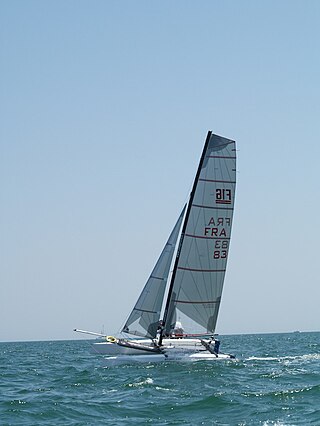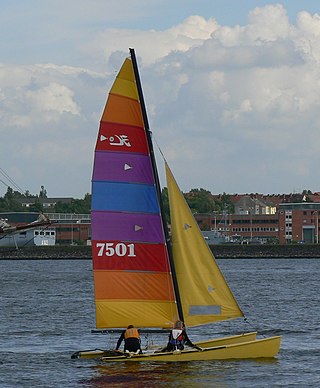
A catamaran is a watercraft with two parallel hulls of equal size. The distance between a catamaran's hulls imparts resistance to rolling and overturning. Catamarans typically have less hull volume, smaller displacement, and shallower draft (draught) than monohulls of comparable length. The two hulls combined also often have a smaller hydrodynamic resistance than comparable monohulls, requiring less propulsive power from either sails or motors. The catamaran's wider stance on the water can reduce both heeling and wave-induced motion, as compared with a monohull, and can give reduced wakes.

The ISAF International Class Hobie 16 (H16) is a popular catamaran manufactured by the Hobie Cat Company for racing and day sailing. The craft was the driving force behind the popularization of beachcats and was recently inducted into the Sailing Hall of Fame.

Hobie Cat is a company that manufactures watercraft and other products as the Hobie Cat Company. "Hobie Cat" can also refer to specific products of the company, notably its sailing catamarans. Its fiberglass catamaran models range in nominal length between 14 feet (4.3 m) and 18 feet (5.5 m). Rotomolded catamaran models range in length between 12 feet (3.7 m) and 17 feet (5.2 m). Other sailing vessels in the Hobie Cat lineup include, monocats, dinghies, and trimarans, ranging in length between 9 feet (2.7 m) and 20 feet (6.1 m). Its largest product was the Hobie 33, 33 feet (10 m) in length. The company's non-sailing product line includes surfboards, kayaks, stand-up paddle boards, pedalboards, eyeware, and e-bikes. It was founded in 1961 by Hobart (Hobie) Alter, who originally manufactured surfboards.

The Formula 18 class, abbreviated F18, is a non-foiling, restricted development, formula-design sport catamaran class. It was started in the early 1990s and quickly grew getting class recognition by World Sailing, with large racing fleets all over the globe.

The Formula 16 (F16) sport catamaran is an ISAF recognised 5 m long beach catamaran with an asymmetric spinnaker setup.
The term beachcat is an informal name for one of the most common types of small recreational sailboats, minimalist 14 to 20 foot catamarans, almost always with a cloth "trampoline" stretched between the two hulls, typically made of fiberglass or more recently rotomolded plastic. The name comes from the fact that they are designed to be sailed directly off a sand beach, unlike most other small boats which are launched from a ramp. The average 8 foot width of the beachcat means it can also sit upright on the sand and is quite stable in this position, unlike a monohull of the same size. The Hobie 14 and Hobie 16 are two of the earliest boats of this type that achieved widespread popularity, and popularized the term as well as created the template for this type of boat.

A sailing hydrofoil, hydrofoil sailboat, or hydrosail is a sailboat with wing-like foils mounted under the hull. As the craft increases its speed the hydrofoils lift the hull up and out of the water, greatly reducing wetted area, resulting in decreased drag and increased speed. A sailing hydrofoil can achieve speeds exceeding double and in some cases triple the wind speed.
Randolph L. Smyth is an American competitive sailor and two-time Olympic silver medalist. He is a multihull specialist, who won two Olympic silver medals racing catamarans, and has won innumerable national and world titles skippering multihulls. In a 2003 profile on him in Sailing World magazine he was described as America's greatest multihull sailor. He was born in Pasadena, California.

The Hobie Tiger or Hobie Tiger 18, is a French catamaran sailboat that was designed by Hobie Cat Europe as a Formula 18 racer and first built in 1995.

The Nacra 17 is a performance catamaran used for sailing. It was designed in 2011, went into production in 2012 and has been the focus of multihull sailing at the Olympic Games since its conception.

The Nacra F18 Infusion was announced in 2006 and launched in January 2007 as a one design racing catamaran conforming to the Formula 18 class rules. It quickly developed into a class in its own right.

The M32 is a class of sailing catamaran designed by Göran Marström and Kåre Ljung and first built in 2010 by Marstrom Composite AB. The design and production rights were sold in 2013 to Aston Harald Composite AB led by Håkan Svensson and run by Killian Bushe.

The Hobie 17 is an American catamaran that was designed by John Wake as a single-handed racer and first built in 1985.

The Hobie 14 is an American catamaran sailing dinghy that was designed by Hobie Alter and first built in 1967.

The Nacra 20 is a catamaran sailing dinghy that was designed by Gino Morrelli and Pete Melvin as a one-design racer and first built in 1998.
The Nacra 5.2 is an American catamaran sailing dinghy that was designed by Tom Roland as a one-design racer and first built in 1975. Other than the small production run Nacra 36, the Nacra 5.2 was the first Nacra brand boat and established its reputation.
The G-Cat 5.0 is an American catamaran sailing dinghy that was designed by Hans Geissler as a one-design racer and first built in 1975.
The Prindle 18 is an American catamaran sailing dinghy that was designed by Geoffrey Prindle as a racer and first built in 1977.

The Hobie 18 is an American catamaran sailboat that was designed by Hobie Alter and Phil Edwards as a one design racer and first built in 1976.

The Nacra F16 is a Dutch catamaran sailing dinghy that was designed by Americans Morrelli and Melvin as a one-design Formula 16 racer and first built in 2011.
















